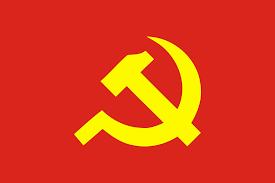Leftist thinking and communism are fundamentally different. Communists are  historically considered leftist because they for a significant part of political history were in opposition. Leftists are a heterogeneous group that includes feminists, environmentalists, free-speech activists and so on and so forth. A communist needn’t be any of the above. But people consider communist as leftist because while in the opposition they espouse many of the ideas the traditional leftist champion.
historically considered leftist because they for a significant part of political history were in opposition. Leftists are a heterogeneous group that includes feminists, environmentalists, free-speech activists and so on and so forth. A communist needn’t be any of the above. But people consider communist as leftist because while in the opposition they espouse many of the ideas the traditional leftist champion.
I consider communism as a totalitarian ideology. They are no different from Wahabi Islam or the reformation era Christianity. Totalitarianism tries to control people ‘totally’. The basis of totalitarian ideology is their claims of ‘truth’. Just as Wahabi Islam claims truth in their ‘book ‘, Marxism claims truth in their tenets which they previously claimed as ‘scientific communism’. All totalitarian ideologies can commit wanton atrocities because they think they are absolutely true, and all their deeds correct because their ‘tenets’ are fundamentally correct. Another aspect of totalitarian ideologies is that they consider ‘individual’ as subservient of the collective. The collective is important and paramount. The individual has to subscribe to the dictates of the collective. Individual liberty has no value. Individuals can be taken down for the ‘benefit’ of the collective. There is nothing morally wrong with it. This is the fundamental difference between totalitarian ideologies and the post-war western concept of liberty.
CPM in Kerala is a ‘pseudo-communist’ party. They became ‘pseudo-communist’ by the constraints of democracy. However, the more you go to the north of Kerala, the more you see ‘totalitarian ‘ traits of CPM.
With respect to Kerala, the communist government was instrumental in certain interventions that had a dramatic effect in the socio-economic spheres of Kerala.
One, the Land reforms and two, directly aiding education in private sector. Land reforms provided the previously poverty ridden bonded labourers a ‘capital resources’ to get out of poverty traps that were so prevalent in the pre-independent Kerala. The ‘aiding’ of private/missionary education brought about government control of the curriculum and the direction of education. It universalized education.
Before this, the social reform movement such as that of Sree Narayana Guru had emphasized the importance of education to the lower castes.
Christian missionaries came to India ‘drooling’ over the vast ‘pagan’ population as the potential opportunity for their conversion mission. But, unlike the Islamic invaders of Northern India, they tend to use the tool of western education to carry out their gentle persuasion.
The early reformers in Bengal, unlike those in Kerala, were all from upper caste strata. They took the missionary efforts as an affront to their Brahminical practices and started to craft a religion similar to that of Semitic religions with a book and a prophet. Social activists like Ram Mohan Roy and Dayananda Saraswati ‘made up’ quite a bit a literature to ‘semitise’ a fundamentally ‘pagan ‘ religious practices of the subcontinent. They got inspired by the exposition of Veda by German missionaries like Max Muller. Max Muller and many other German and British scholars, on the contrary, considered the corpus of Veda as a means of ‘rediscovering’ their ‘Aryan’ roots. They invented an imaginary ‘Aryan’ common ancestor for the Vedic Indians and the European Caucasians. This was an instrument to do away with the Jewish roots of Christianity. They ‘invented’ an elaborate migration myth and considered Vedic Aryans as ‘pure breeds’, and the present day Hindus as ‘degenerates’ because of intermingling with mongrel Dravidians and other lesser mortals. Dayananda Saraswati et al got inspired by these ‘myths’ and himself started to weave another set of myths which conceptualized a golden age for Hindus in India, that was subsequently destroyed by Invasion by Central Asian barbarians including the Islamic Turks and Muguls. The ideological basis of BJP is the myth created by these Bengali reformers.
In Kerala, the reform movement started from below up. It started with the Dalit Ayangali, consolidated with Narayana Guru, and was subsequently continued by the communist movement. The Communist movement did what Martin Luther did for Germany during the German Reformation. It promoted mass literacy. With the land reforms, it provided ‘capital’ for the masses to get out of ‘poverty traps’. Government aiding of education sector made education accessible to the neo-literate masses who were just out of poverty trap. Gulf boom allowed the outputs of the mass education drive to tap into the opportunity available overseas.
In Bengal, the reformist movement was from top down, while in Kerala the reformist was from bottom up. While in Bengal, reforms just layered about the Hindu revivalist movement spearheaded by Vivekanda et al, in Kerala it was owned by the ‘Buddishoid’ reformist movement advocated by the likes Ayankalli and Sree Narayana Guru. The lack of opposition to communist parties in Bengal led to the development of totalitarian tendencies in the state ( the real nature of communist parties throughout the world), while in Kerala the totalitarian tendencies were tempered by contrarian movements, whether of the far left or the centre-left. The rapid alternation of governments in Kerala, prevented the development of totalitarian nature of the communist elsewhere in the world. Thus, what we have in Kerala is a ‘social democrat’ party more-or-less similar to that evolved in the post-war Western Europe. But to have a taste of the ‘real’ flavour we have ‘totalitarian’ communism in the party villages of North Kerala. CPM in Kerala is a ‘pseudo-communist’ party. They became ‘pseudo-communist’ by the constraints of democracy. This constitutes the North-South gradient of totalitarianism and social democracy in the CPM in Kerala. It also characterizes the communist-pseudo-communist spectra of the party.
Hits: 241
